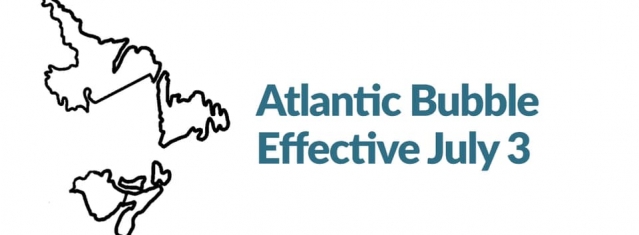Travel
Atlantic Canada Travel
During COVID-19 Pandemic

Atlantic Bubble Map (Source: Social Media)
USPA NEWS -
As of June 24th, 2020, the total number of COVID-19 cases in Canada is 102,179 of which 28,763 are active, 64,933 have recovered, and 8,483 deaths. The following is a breakdown of cases by province. The total number of cases in British Columbia is 2,835 with 174 active, 2,491 recovered, and 170 deaths. In Alberta, the total number of cases is 7,781 of which 532 are active, 7,096 are recovered and 153 deaths. In Saskatchewan, the total number of cases is 753 with 98 active cases, 642 recovered, and 13 deaths. In Manitoba the total number of cases is 315 of which 15 are active, 293 recovered, and 7 deaths. In Ontario, the total number of cases is 34,016 of which 2,049 are active, 29,336 are recovered, and 2,631 deaths. In Quebec, the total number of cases is 54,937 with 25,876 active, 23,620 recovered, and 5,441 deaths. In New Brunswick, the case total is 165 with 16 active, 147 recovered, and 2 deaths. In Nova Scotia, the total number of cases is 1,061, with 0 active, 998 recovered, and 64 deaths. In Prince Edward Island, the case total is 27 with no active cases and no deaths. In Newfoundland, the case total is 261, with 258 recovered and 3 deaths.
As summer officially arrived this past weekend, officials across the country are beginning to loosen some of the COVID-19 restrictions. This is being welcomed enthusiastically by Canadians who for the most part have been self-isolating for the last several months. As long as Public Health rules are followed people are now allowed to return to parks, beaches, campgrounds, restaurants, bars, coffee shops, retail outlets, hair salons, and barbershops. Also
Premier Stephen McNeil has announced that the family bubble has been extended to 10 people without social-distancing and public gatherings can have a maximum of 50 people, but social-distancing applies. Also, family members can now visit with loved ones who are in long term care homes, but the visit must take place outside and social-distancing must be followed.
On June 21st, Premier Stephen McNeil released the following statement on Facebook, "I hope Nova Scotians were able to reconnect with their loved ones and enjoy the outdoors this weekend. Thank you to all Nova Scotians for their hard work - it has not been easy, but our efforts are paying off. Please continue to be safe and follow public health advice."
With the Canada-USA border closed to non-essential travel until at least July 21st, some provincial borders closed to non-essential travel, and strick self-isolation rules when entering other provinces, the summer travel plans for many Canadians may look much different than originally planned. People are being encouraged to enjoy vacation destinations within their own region, which will not only support the local economy but also help eliminate the spread of COVID-19. Today, June 24th, with that in mind Premier McNeil announced, " As of July 3rd, Nova Scotia will form an Atlantic Bubble with New Brunswick, Prince Edward Island, and Newfoundland, allowing Atlantic Canadians to travel within the region without having to self-isolate. This decision was guided by the Chief Medical Officers of Health in each province and will continue to be closely monitored. All public health directives present in each province must continue to be adhered to, including not traveling if you have any symptoms of COVID-19 and practicing physical distancing and good hygiene."
This is extremely good news for tourism operators and small businesses throughout Atlantic Canada who are struggling to keep in operation because of all the financial loss due to the COVID-19 pandemic. With the 2020 cruise ship season in Atlantic Canada canceled, passenger train service on pause until the fall, and a major drop in air travel, it is crucial that Atlantic Canadians support the local economy as every dollar is crucial for survival.
What a great time for everyone to get out and rediscover the beauty and attractions that can be found in our own back yard.
Liability for this article lies with the author, who also holds the copyright. Editorial content from USPA may be quoted on other websites as long as the quote comprises no more than 5% of the entire text, is marked as such and the source is named (via hyperlink).






